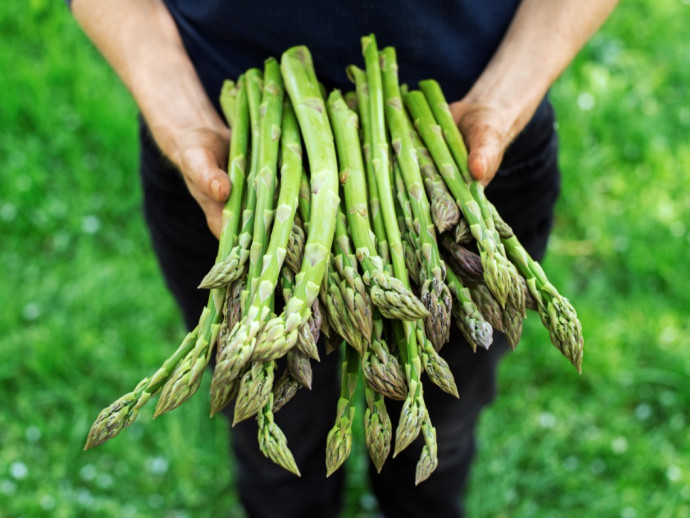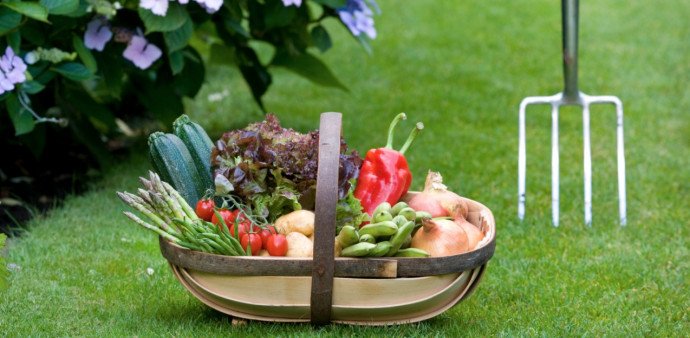Asparagus

Parsley planted with asparagus gives added vigor to both. Asparagus also does well with basil, which itself is a good companion for tomatoes. Tomatoes will protect asparagus against asparagus beetles because they contain a substance called solanine. Cultivating the tomatoes also keeps down the weeds from the asparagus. But if asparagus beetles are present in great numbers, they will attract and be controlled by their natural predators, making spraying unnecessary. A chemical derived from asparagus juice also has been found effective on tomato plants as a killer of nematodes, including root-knot, sting, stubby root, and meadow nematodes.
Grow with asparagus: tomatoes, parsley, basil
Avoid growing near asparagus: onion, garlic, potatoes
Broccoli

Broccoli does well with such aromatic plants as dill, camomile, celery, peppermint, sage, and rosemary, and with other vegetables such as potatoes, beets, and onions. Do not plant it with tomatoes, pole beans, or strawberries. Use pyrethrum on broccoli against aphids, before the flower buds open.
Grow with broccoli: beets, lettuce, onions, tomatoes, turnips, potatoes
Avoid growing near broccoli: pole beans, strawberries
Beans

There are many different types of beans, and they all have slightly different companion plants. However, generally, beans of any variety thrive when planted with carrots, cauliflower, and beets.
Grow with beans: beets, broccoli, cabbage, cucumbers, cauliflower, carrots, corn, eggplant, peas, radishes, squash, potatoes, tomatoes
Avoid growing near beans: onions, garlic, shallots, chives, peppers
Cabbage

The cabbage (brassica) family has several popular members which all have similar likes, dislikes, diseases, and insects. The cabbage family includes not only cabbage but cauliflower, kale, kohlrabi, broccoli, collards, and brussels sprouts — even rutabaga and turnip. While each plant of this group has been developed in a special way, they are all pretty much subject to the same likes and dislikes, insects and diseases. Hyssop, thyme, wormwood, and southernwood are helpful in repelling the white cabbage butterfly.
Grow with cabbage: onion, celery, potatoes, dill, rosemary, cucumbers, kale, lettuce, spinach, thyme
Avoid growing near cabbage: tomatoes, strawberries, pole beans
Beets

Beets grow well near bush beans, onions, and kohlrabi but are “turned off” by pole beans. Field mustard and charlock inhibit their growth. Lettuce and most members of the cabbage family are “friendly” to them.
Grow with beets: garlic, bush beans, onions, kohlrabi, lettuce, cabbage family
Avoid growing near beets: pole beans
Carrots

Carrots love onions because onions repel the carrot fly. Also, carrots are heat sensitive, making them perfect to grow with tomatoes which can provide some shade. Leeks repel carrot flies, making them good companion planting vegetables.
Grow with carrots: onions, leeks, tomatoes, leaf lettuce, chives, radishes
Avoid growing near carrots: dill, coriander, parsnips
Corn

Since cucumbers and raccoons don’t mix (they refuse to walk on the prickly vines), grow cucumbers near your corn to keep the raccoons away. Corn also loves any vegetable that will add nitrogen to the soil (which corn depletes quickly), so growing green beans nearby will make your corn happy while the corn makes a great natural trellis for your beans.
Grow with corn: zucchini, beans, peas, cucumbers, pumpkins, melons
Avoid growing near corn: tomatoes (they are both attacked by the corn earworm)









This was a great help. Thank you. This will be my first try to grow a garden in AR